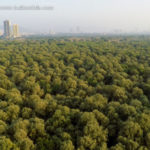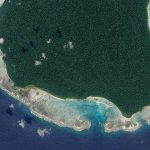IndiaWilds Newsletter Vol. 14 Issue I
ISSN 2394 – 6946
Indiscriminate Tree Plantations: Ecosystem Vandalism

IndiaWilds Newsletter PDF – March 2022
Every kid is taught in school that chlorophyll in the leaves take carbon dioxide from the air and converts into energy and release oxygen. Trees release moisture into the air and that also leads to rainfall. The roots of trees help bind the soil and as a result prevent soil from being eroded. Also, the direct benefit of fruits, flowers and timber as well as for fuel wood makes tree plantation capture the imagination of people as a good deed. The way our school and college curriculum has been designed; students don’t learn more than these few lines about the beneficial impact of trees. No wonder, Officers in India as well as in many other countries are by and large ecological illiterates. So, when tasked with creating India’s response for affirmative action on Climate Change, our bureaucrats have fallen back to what they leant in school ie. on tree plantation.
India has decided that it would undertake tree plantations in 13 major river basin, spread over a humongous 4,68,222 square kilometer area. The river basins selected for tree plantations are Jhelum, Chenab, Ravi, Beas, Sutlej, Yamuna, Brahmaputra, Luni, Narmada, Godavari, Mahanadi, Krishna and Cauvery. The Government officials believe these tree plantations in such a large area will help meet India’s commitment to fight climate change as tree plantations over such a large area should help in sequestering enough carbon dioxide from the air. The Environment ministry officials believe that over a 10 year period such large scale plantations would be result in 50.21 million tonnes of carbon sequestration. They have even further extrapolated to 74.76 million tonnes in 20 years. In this numbers game, the forest cover is expected to become 1813.52 km2, an increase of 80.85 km2.
The premise on the surface appears very simple. The projected numbers make the current administrators and Government happy as India can now show that it is taking action to fulfil its climate change mitigation obligations as agreed upon in the Paris Agreement. However, the devil lies in the details.
There are some serious problems that our Government officials and the consultants who are making the project plans are not aware off. Ecology is not just a numbers game. When you plant a tree, it is a micro-ecosystem in itself. There are lots of complex ecological relationships at play in forests between plants, trees, birds, bees, reptiles, animals, soil, water and air and numerous organisms from microscopic in size to huge herbivores and carnivores.

Coniferous trees
Traditionally the river basins had a different riparian ecosystem. The ignorant hand of man has resulted in the decimation of the same. Many of the trees and bushes, reeds and creepers have been simply cut off. As a result the river banks are often devoid of any vegetation. In those river banks roots of trees used to help stabilize the banks. However, indiscriminate planting of trees would completely change the landscape.
People don’t understand the difference between fallow land and river flood plains. The flood plains are there for a reason. When there is more water, the flood plains by design are supposed to get submerged. Unfortunately, these days indiscriminate construction is being done in the floodplains. This results in flooding of those concrete structures during rains and floods. The mindless concretization also results in putting pressure on the river to alter its course and as a result villages and human habitations at other places get submerged. Instead of concretising in the name of river front development, if there is only tree plantations without creating any concrete structures, which appears really impossible due to the current thought process of people, then the trees can grow and will go underwater whenever there is flood. Nature will take its own course.
However, even for planting of trees, one needs to know which species to plant. Monoculture doesn’t help due to the lack of ecological relationships between species. Historically it is seen that tree planters don’t understand that only native species should be planted. Exotic species are not beneficial for our landscape. Even though exotic species can adapt to a particular place, they take a serious toll on the environment. They outcompete native vegetation and also have a huge financial impact on us.

River Ganga
When you plant non-native species in the river basins, the riparian ecosystems are altered. The habitat of the existing species of flora and fauna in the river basins would be destroyed. Some of the species can become locally extinct.
To alleviate this concern Government has to employ qualified scientists to survey and analyse the terrain and specify the species that need to be planted in each area. However, when they do this, scientists who understand ecology will report back that simply there is not much land available for plantations.
In most of the river basins, there are existing encroachments and concrete structures that needs to be cleared. In river basins that are not impacted by sand mining or illegal mining for minerals, and don’t have much anthropogenic pressures, nature would have already taken care of it. In fact, any landscape from where man retreats for sufficient length of time, nature reclaims it. Even concrete structures start getting overgrown by native trees.
In many reported cases, native forests have been illegally clear felled to make way for plantations. When an area is branded as plantations, later on vested interests will come back again and again to harvest it for timber. The carbon sequestration potential of mature hard growth trees are much better than saplings. So, when river basins are cleared up to make way for plantations, there would in fact be net addition to carbon emissions.
When existing forests are clear felled to make way for plantations, immediately there is a loss in moisture which used to earlier get emitted from the forests due to evapotranspiration. Without this the microclimate of the area changes. The species composition of the areas change from species adapted to wet climate to ones that thrive on dry climate.
Recent studies have shown that climate change is having an important impact on the loss of tropical forests in India. A study by University of Reading (“Determining the Role of Climate Change in India’s past forest loss; Haughan et al., March 2022, Global Change Biology) found that there were far greater forest losses due to rapidly changing climate. Reduction in precipitation was seen to have the strongest effect on increasing the forest loss. It concluded that “understanding the different regional and seasonal relationships between climatic conditions and forest distributions will be key to effective protection of the country’s remaining forests as climate change accelerates.” In view of this the Government has to be ultra careful to avoid past practices of clear-felling forests to make way for tree plantations. Except for people involved in the projects making money, not much would be achieved if the officials continue to implement the way they have done plantations in the past.
Land use change is the leading cause of forest declines worldwide (Choe & Thorne, 2017; “Integrating climate change and land use impacts to explore forest conservation policy; Forests, 8(9), 321). Even though the present proposal of tree plantation is not officially land use change, it would be pertinent to mention that the way these kinds of projects are executed the impact is similar. Too often the concept of beauty ingrained in the minds of Government officials and project proponents is far removed from ecology. In India as well as in many places worldwide, the term River front development is synonymous with urban parks where concrete walkways, benches, toilet facilities, cement steps and roads are constructed. To make it look green imported grass is planted to create lawns, and exotic flowering plants are planted to beautify it. In fact, we see similar things in forest offices. What is good for Nature may not match the traditional sense of aesthetics of the ecologically illiterate officials.
The existing river basin tree plantation idea is like handing over knife to a person who has never seen a knife and asking him to operate on an ailing patient. The outcome of such a misadventure is easier to predict.
We have constructed way too many dams in our rivers. Our Government never did a river basin level study of the environment impact assessment of constructing dams. As a result, most of our rivers don’t have the minimum ecological flow to sustain life. There is huge environmental impact due to the mindless dams and hydro-power projects. To start with, Government should start dismantling some of the old dams where the power generation capacity has gone down, and where water carrying capacity has gone down due to siltation. The cost of solar has become so cheap, we can start dismantling some of these dams. In USA, they have started dismantling old dams and allowing their rivers to flow free and unmanaged. Once that happens, nature will start taking its own course. Just leave the river basins wild and unmanaged and native vegetation will start growing.
Wherever, exotic Lantana, Prosopis and other such weeds have propped up, only such lands should be taken up for uprooting of the weeds and plantation of native vegetation. Else, these mindless tree plantation projects in the river basins can cause more harm to our nature than good.
Article:
Probable First Record of Indian Roofed Turtle (Pangshura tecta, Gray 1831) From Freshwater Inland Wetland, Gujarat, India
by Hiren J. Chaudhari and Hiren B. Soni
Chilika : Changes observed during a decade long love affair with Chilika
By Shakti Bishnoi – Photos by AS Bishnoi
Changes observed during a decade long love affair with Chilika
Conservation News:
Preventing biodiversity loses due to invasive alien species
24th March, 2022
Alien species cause huge impact on the biodiversity. They outcompete native species and cause huge financial impact on our economy as well. This fact was acknowledged by the Minister of State for MoEF&CC Shri Ashwini Kumar Choubey while answering a question on the Rajya Sabha on 24th March, 2022. The Government of India reportedly maintains and updates its database of invasive alien species. According to Zoological Survey of India (ZSI), a total of 154 species of faunal communities including 56 species from terrestrial and freshwater ecosystem and 98 species of marine ecosystems are recorded from India as exotic/ invasive species.
The action plan of Government to prevent the reproduction and proliferation of invasive species includes strengthening of quarantine facilities at airport and seaport, strict compliance of IMO (International Maritime Organization) norms for ballast water disposal; evaluation on the impact assessment on the exotic species. Also this includes regulation of the introduction of exotic species for commercial venture; assessment of the growth rate, reproduction success, dispersal ability and tolerance during climatic stress of exotic species, status surveys on introduced /exotic/invasive species. No licenses are issued for cultivation of invasive alien species and no such information is collated in this Ministry.
Unfortunately, the ministry is completely oblivious to the exotic fishes released into the wild by various fisheries departments throughout the country. The Department of Fisheries, Government of Karnataka released 4 Lakhs exotic Common Carp Fingerlings into the Chakra reservoir on 24th March 2022, in presence of Additional Director of fisheries (Inland) Thippeswamy D and other officials. If the idea was to help the fishermen, then the fisheries department could have released any Indian fish instead of European fish.
4 Lakhs Common Carp Fingerlings were stocked at Chakra reservoir in presence of Additional Director of fisheries (Inland) Thippeswamy D, (1/2)
— Department of Fisheries, Govt of Karnataka (@dof_kar) March 26, 2022
It would also be pertinent to mention that the Government of India is allowing import of exotic African Cheetah from Namibia to India. African Cheetah are a different species than the Asiatic Cheetah which has been extinct in India. Asiatic cheetahs are still found in small numbers in Iran. The project was earlier stuck down by the Supreme Court. However, with change in Government at the centre and change in chief justices, somehow a new order allowing import of exotic African cheetah has been allowed into India. Since it suits the project proponents, they even say that there is virtually no difference between African and Asiatic cheetah. Policy should not change simply because of commercial or other considerations.
Since African cheetah which is an alien species is allowed to be imported into India, and uncontrolled release of exotic fishes continues in various parts of India by Government departments, it shows the Government is not serious about creating an viable foolproof action plan to prevent proliferation of invasive species.
Unusual rise in temperature due to climate change
24th March, 2022
Climate Change is a global collective action problem which has precipitated mainly due to historical, cumulative emissions by the developed countries arising from the disproportionate and excessive production and consumption. The advances in the science of climate change is periodically assessed by the Intergovernmental Panel on Climate Change (IPCC). The IPCC Sixth Assessment Working Group I report points to three major facts: First, that global average temperature has already risen by 1.07 degree C since pre-industrial times. Second, we only have a certain amount of carbon budget left before we reach the temperature limits of 1.5 degree C and 2 degree C mentioned in the Paris Agreement. And third, historical cumulative emissions are an important determinant of current climate change. Carbon budget is the cumulative amount of carbon dioxide emissions permitted since the pre-industrial era to keep the increase in global average temperature, over pre-industrial levels, within a certain limit. For 1.5 degree C warming, 83% of carbon budget is already taken up by historic cumulative emissions until 2019. So, for a temperature target of 1.5 degree C increase, there is only 500 Gt of carbon dioxide that the world can emit. Compared to what has been emitted thus far, this is quite small. While for 2 degree C, 65% is taken up by historic cumulative emissions and 35% remains for the whole world.
India with more than 17% of the global population has contributed only about 4% of the global cumulative greenhouse gas emissions between 1850 and 2019. India firmly believes in global cooperation to deal with the challenge of climate change through multilateral processes on the basis of the principles of equity and Common but Differentiated Responsibilities and Respective Capabilities (CBDR-RC). Hence all countries must keep their emissions to their fair share of the global carbon budget and use it responsibly. At the same time, technological development is needed globally to move to a low-carbon development pathway while the excessive and unsustainable lifestyles of the developed countries must be immediately curbed and transformed. Simultaneously, development and adaptation is necessary to manage the impact of the climate change that is already taking place.
The Government is seized of the matter. Studies show that average temperature over India has warmed around 0.7˚C during 1901-2018 and similar warming has been observed in the sea-surface temperature in the tropical Indian Ocean by 1˚C for 1951-2015. The rise in temperature is gradual. The rise in extreme events is attributed to the complex earth system interactions due to global warming and regional anthropogenic influences.
Ministry of Earth Sciences (MoES) has the mandate to provide forecasts and early warnings. However, as an adaptive measure to minimize the effects of increasing temperatures, India Meteorological Department (IMD) in collaboration with local health departments have started heat action plan in many parts of the country to forewarn about the heat waves and also advising action to be taken during such occasions. Heat action plan became operational since 2013. National Disaster Management Authority (NDMA) and IMD are working with 23 states prone to high temperatures at present with respect to heat action plan.
The monitoring of glaciers is pursued by the Indian Space Research Organization (ISRO), Geological Survey of India (GSI), Ministry of Earth Sciences (MoES), Defence Geo informatics Research Establishment (DGRE), and also through various research projects sponsored by the Department of Science and Technology (DST). The latter also has an autonomous institution on Himalayan Geology, namely, the Wadia Institute of Himalayan Geology, Dehradun. The Central Water Commission (CWC) monitors 477 glacial lakes and water bodies in the Himalayan Region of the Indian river basin system, having an area of more than 50 hectares on a monthly basis in the monsoon season since 2011. Further, the National Disaster Management Authority has issued guidelines titled “Management of Glacial Lake Outburst Floods (GLOFs)” in October 2020, which inter-alia includes a discussion on early warning systems.
The Government is implementing the National Action Plan on Climate Change (NAPCC), which is the overarching policy framework for climate action in India, covering mitigation, adaptation and generation of strategic knowledge on climate change. It comprises of national missions in the specific areas of solar energy, enhanced energy efficiency, water, agriculture, the Himalayan eco-system, sustainable habitat, green India and strategic knowledge on climate change. Further, 33 States/Union Territories have prepared State Action Plans on Climate Change (SAPCCs) consistent with the objectives of NAPCC. The Government is also implementing the National Adaptation Fund for Climate Change to support adaptation measures of States/UTs in areas that are particularly vulnerable to the adverse impacts of climate change. A number of other measures are taken, keeping in view the threat of climate change, by various departments, ministries and entities of the Government, as part of their regular mandated activities and responsibilities. These are periodically shared with all stakeholders and the world through India’s National Communications and Biennial Update Reports submitted to the United Nations Framework Convention on Climate Change.
This information was given by Shri Ashwini Kumar Choubey, Minister of State, Ministry of Environment, Forest & Climate Change in Rajya Sabha on 24th March 2022
Ban on single use plastics
21, March 2022
The Plastic Waste Management Rules (PWMR), 2016, provides the statutory framework for plastic waste management in an environmentally sound manner throughout the country. Thirty Four States/UTs have issued notifications/orders introducing regulations pertaining to complete or partial ban on plastic carry bags and/or identified single-use plastic items, over and above the Plastic Waste Management (PWM) Rules, 2016, as amended. The details are annexed.
The following steps have been taken to strengthen implementation of Plastic Waste Management Rules, 2016 and also to reduce the use of identified single use plastic items:
The States/UTs have been requested to constitute a Special Task Force under Chairpersonship of Chief Secretary/Administrator for elimination of single use plastics and effective implementation of PWMR, 2016. Thirty two States/UTs have constituted the Special Task Force till date. A National Level Taskforce has also been constituted by the Ministry in this regard. The State /UT Governments and concerned Central Ministries/Departments have also been requested to developa comprehensive action plan and implement it in a time bound manner. Fourteen States/UTs and twelve central ministries have developed their comprehensive action plans.
The Ministry of Environment, Forest and Climate Change has notified the Guidelines on the Extended Producer Responsibility for plastic packaging vide Plastic Waste Management Amendment Rules, 2022, on 16th February, 2022. Directions have been issued to E-commerce companies, leading single use plastic sellers/users, and plastic raw material manufacturers with respect to phasing out of identified single use plastic items.
Additional Central Assistance is also provided to States and Union territories for solid waste management including plastic waste management, under Swachh Bharat Mission Urban (SBM (U)) and Swachh Bharat Mission Grameen. Single use plastic ban has been incorporated as an important component in Swachh Survekshan 2022, Star rating of Garbage Free Cities and as an entry condition for participating in Safaimitra Suraksha Challenge, to reduce plastic waste.
As per the Plastic Waste Management (PWM) Rules, 2016, there is complete ban on sachets using plastic material used for storing, packing or selling gutkha, tobacco and pan masala. Based on high littering potential and low utility, the Ministry has also notified the Plastic Waste Management Amendment Rules, 2021, on 12th August 2021, prohibiting manufacture, import, stocking, distribution, sale and use of the following identified single use plastic items, which have low utility and high littering potentialwith effect from the 1st July, 2022:
- ear buds with plastic sticks, plastic sticks for balloons, plastic flags, candy sticks, ice-cream sticks, polystyrene [Thermocol] for decoration;
- plates, cups, glasses, cutlery such as forks, spoons, knives, straw, trays, wrapping or packing films around sweet boxes, invitation cards, and cigarette packets, plastic or PVC banners less than 100 micron, stirrers.
Annexure
Notification for banning manufacture, use, sale import and handling of single use plastic products
(Based on the data available in submitted Annual reports by SPCBs/PCCs)
| S. No | Name of State/UT | Complete or Partial Ban | Date of Gazette or Executive Order | Remarks |
| 1 | Andaman & Nicobar Islands | Complete ban | 02.08.2010
(Gazette) |
Complete ban on manufacture, store, import, distribution, transportation, recycle, sell & use of plastic carry bags. |
| 2 | Andhra Pradesh | Not Banned | Not Available | Not Banned |
| 3 | Arunachal Pradesh | Complete ban | 03.07.2012
(Executive Order) |
Complete ban on manufacture, store, import, transportation, sell& use of polythene/plastic carry bags |
| 4 | Assam | Complete Ban | 30.04.2019
(Gazette) |
Plastic carry bags, banners, buntings, cups, cling films, flex, flags, plates, sheets (used for spreading on dining tables irrespective of thickness) including the above items made of thermocol and plastic which use plastic micro beads. |
| 5 | Bihar | Complete ban | 11.12.2018
(Gazette) |
Complete ban on manufacture, store, import, transportation, sell& use of plastic carry bags |
| 6 | Chandigarh | Complete ban | 30.07.2008
(Gazette) |
Complete ban on manufacture, storage, import, sale, use transportation & disposal of plastic carry bags |
| 7 | Chhattisgarh | Complete ban | 24.12.2014
(Gazette) |
Complete ban on manufacture, store, import, transportation, recycle, sell & use of polythene/plastic carry bags. |
| 8 | Daman Diu & Dadra Nagar Haveli | Complete ban | 24-01-2014 & 22.09.2017
(Gazette) |
Forbidding the use, sale/ storage of all kinds of plastic bags |
| 9 | Delhi | Complete ban | 23.10.2012
(Gazette) |
Complete ban on manufacture, import,store, sell & use of plastic products (poly Propylene, non-woven fabric type carry bags), plastic film or plastic tube to pack or cover any book including magazine & invitation/greeting cards. |
| 10 | Goa | Partial ban | 16.03.2015 | Government imposed ban on Manufacture, stock, import, transportation, recycle, sale & use of plastic (carry bags, cups, forks, paper plates, spoons) in ChorlaGhat area Mandi Wildlifesanctuaries . |
| 11 | Gujarat | Partial ban | 28.06.2011
(Gazette) |
Complete ban on plastic products in Gandhi Nagar |
| 12 | Haryana | Complete ban | 20.08.2013
(Gazette) |
Complete ban on manufacture, stock, import, transportation, recycle, sell & use of plastic (carry bags, cups, forks, paper plates, straws, spoons& containers for the usage of foodstuffs) |
| 13 | Himachal Pradesh | Complete Ban | 07-07-2009
& 13-08-2009 (Gazette) |
Complete ban on use of Carry bags (irrespective of size), polythene, non-biodegradable material, disposable plastic cups, plates, and glasses |
| 14 | Jammu & Kashmir | Complete Ban | 03.01.2017 (SRO 45 order-Notification)
Jammu District Magistrate has on 01.10.2020 ordered strict enforcement of SRO 45 notification. |
Complete ban on manufacture, stocking, distribution, sale and use of polyethylene carry bags, plastic sheets or like, cover made of plastic sheet, plastic packaging and multilayered packaging less than fifty microns in thickness within territorial limits of the State of Jammu and Kashmir. |
| 15 | Jharkhand | Complete Ban | 17.10.2017
(Gazette) |
Complete ban on manufacture, import, storage, transport, sell and usage of
plastic carry bags in the whole State |
| 16 | Karnataka | Complete ban | 11.03.2016
(Gazette) |
State government banned the plastic banners, buntings, carry bags (plastic & compostable), cups, cling films, flex, flags, plates, spoons & sheets made of plastic or Thermocol and microbeadsusage in the entire state |
| 17 | Kerala | 01.01.2020
(Executive Order) |
22.11.2010
(Executive Order) |
Complete ban on the manufacture, storage, transport and sale of plastic carry bags( irrespective of thickness); plastic sheets( used as table spread); plates, cups and decorative materials made of thermocol/stryrofoam; SUP items like cups, plates, dishes, spoons, forks, straw, stirrer; plastic coated paper cups, plastic coated paper plates, plastic coated paper bowls, plastic coated paper bags; Non woven bags, plastic flags, plastic bunting; plstic water pouches, non branded plastic juice packets ; plastic juice packets; PET/PETE bottles of drinking water of capacities less than 500 ml; garbage bags (plastic); PVC flex materials and plastic packets. |
| 18 | Ladakh | Partial Ban | (Order no-40-LA (GAD) of 2020 dated 23.06.2020) | Ban on the use of plastic water bottles and other plastic made objects in Government offices and other institutions |
| 19 | Lakshadweep | Complete ban | 25.01.2019
(Gazette) |
Complete ban on use, store & sale of plastic carry bags of all thickness, plastic coated carry bags, plastic flags, plastic sheets/films used for wrapping, plastic sheets used as dining table covers, thermocol cups and plates, plastic coated paper cups and plates, plastic teacups, plastic tumblers, plastic teacups, water pouches/packets/PET plastic water bottles, straws, |
| 20 | Madhya Pradesh | Complete ban | 24-05-2017
(Gazette)
|
Production, Storage, Transportation, sale & use of plastic carrybags. |
| 21 | Maharashtra | Complete Ban | 23-03-2018
(Gazette) Amendment 11th April, 2018 |
Complete ban in the whole State for manufacture, usage, sale storage,transport, and distribution, wholesale & retail, import of the plastic& compostable bags and the disposable products manufactured from plastic &thermocol (polystyrene) – disposable dish/spoon, cups, bowl, container, fork, plates, glasses, straw, non-woven polypropylene bags, cups/pouches. |
| 22 | Manipur | Complete Ban | 12.9.2017
Notification no. 56/38/99 for&Envt |
Complete ban on use, store & sale of plastic carry bags |
| 23 | Meghalaya | Partial Ban | 16.2.2017
Notification No. MPCB/TB-144B/2016-2017/79 |
Use and sale of plastic bags less than 50 microns has been prohibited and public notice has been issued |
| 24 | Mizoram | Partial Ban | With effect from 1.8.2019
By Aizwal Municipal Corporation |
Complete ban on plastic carry bags below 50 microns |
| 25 | Nagaland | Complete ban | 01.01.2004
(Gazette) |
Complete ban on use, store & sale of plastic carry bags |
| 26 | Odisha | Partial ban | 29.09.2018
(Executive Order) |
Ban on use and sale of plastic carry bags, bottled drinking water Polyethylene Terephthalate bottles of less than 200 ml capacity; SUP disposable cutleries like thermocol (polystyrene), dish/spoon, cups, bowl, container, fork, glasses & plates in Bhubaneshwar, Berhampur, Cuttack, Puri, Rourkela &Sambalpur |
| 27 | Puducherry | Complete ban | 30.07.2019 | (i) Polythene/Plastic/Polypropylene carry bags; (ii) Polythene/Plastic/Styrofoam (Thermocol) cups; (iii) Polythene/Plastic/Styrofoam (Thermocol) plates; (iv) Plastic sheet pouches used for cooked food wrapping; (v) Plastic sheets used for spreading on dining table; (vi) Water pouches; (vii) Plastic straw; (viii) Plastic flag. |
| 28 | Punjab | Complete ban | 18.02.2016
(Gazette) |
Complete ban on Manufacture, stock, distribute, recycle, sale & use of plastic carry bags. |
| 29 | Rajasthan | Complete ban | 01.08.2010
(Gazette) |
Complete ban on use, store & sale of plastic carry bags |
| 30 | Sikkim | Complete ban | 19.05.2016
(Gazette) |
Complete ban on sale & use, storage of disposable items (cups, plates, spoons, containers, etc..) made from Styrofoam. |
| 31 | Tamil Nadu | Complete Ban | 01.01.2019
(Gazette) |
Complete ban on manufacture, sell, use, storage, Transportation and distribution of “Single-use plastics” i.e. plastic carrybags, flags, sheets using for food wrapping, straws, tea cups, tumblers, water packets & pouches |
| 32 | Telangana | Not Banned | Not Available | Not Banned |
| 33 | Tripura | Complete ban | 10.03.2015
(Gazette) |
Complete ban on Sell, use, storage, Transportation & import of plastic carrybags (including polypropylene, non-woven fabric type) plastic tube to pack or cover any book including magazine & invitation/greeting cards. |
| 34 | Uttar Pradesh | Complete ban | 22.12.2015
(Gazette) |
Sell, use, Storage, Transportation & import of plastic carrybags (including polypropylene, non-woven fabric type) plastic tube to pack or cover any book including magazine & invitation/greeting cards. |
| 35 | Uttarakhand | Complete Ban | 01.01.2017
(Gazette) |
Sell, use, storage& Transportation, of plastic carry bags. |
| 36 | West Bengal | Partial ban | 11.01.2018
(Executive Order) |
Completely banned in religious and historical places. |
Million Tons of E-Waste Generated in India
21st March 2022
Under the E-Waste (Management) Rules, 2016, twenty-one (21) types of electrical and electronic equipment (EEE) have been notified for fulfilling EPR obligations. These notified EEE, at the end of their life become E-Waste. The input data for estimation of generation of e-waste is available only from Financial Year (FY) 2017-2018 and only at national level. Information regarding national level e-waste generation for the financial year 2017-18, 2018-19 and 2019-20 is given in the table below:
| S. No. | Financial Year | Generation (Tonnes) |
| 1. | 2017-2018 | 7,08,445 |
| 2. | 2018-2019 | 7,71,215 |
| 3. | 2019-2020 | 10,14,961.2 |
The import and export of hazardous and other wastes is regulated under the Hazardous and Other Wastes (Management and Transboundary Movement) Rules, 2016 notified by the Ministry. Government had banned import of e-waste in the country by listing e-waste in the Schedule VI (Basel No. A1180) of the said rules. The increase in generation of e-waste is due to increase in the sales of EEE in the Country in previous years.
The Government already has a system in place to monitor EPR obligations related to Producers/Producer Responsibility Organisations (PROs) as per the E-Waste (Management) Rules, 2016. The existing EPR targets are as follows:
| S.No. | Year | E-Waste collection Target (Weight) |
| (i) | 2017-2018 | 10% of the quantity of waste generation as indicated in Extended Producer Responsibility Plan. |
| (ii) | 2018-2019 | 20% of the quantity of waste generation as indicated in in Extended Producer Responsibility Plan. |
| (iii) | 2019-2020 | 30% of the quantity of waste generation as indicated in in Extended Producer Responsibility Plan. |
| (iv) | 2020-2021 | 40% of the quantity of waste generation as indicated in in Extended Producer Responsibility Plan. |
| (v) | 2021-2022 | 50% of the quantity of waste generation as indicated in in Extended Producer Responsibility Plan. |
| (vi) | 2022-2023 | 60% of the quantity of waste generation as indicated in in Extended Producer Responsibility Plan. |
| (vii) | 2023 onwards | 70% of the quantity of waste generation as indicated in in Extended Producer Responsibility Plan. |
The rules provide for monitoring of EPR of E-Waste through CPCB, for which online portal has been developed in which target of each producer/PRO is duly assigned based on their production data of items as listed in Schedule-I of the Rules. Under the provisions of existing rules, penalty can be levied on defaulting producers/PROs and the obligation would have to be fulfilled even after the levy of penalty. The EPR targets were revised in financial year 2021-22 from 50% to 40% based on the representations received from the industry and in view of the pandemic.
Resolution on Plastic Pollution adopted at 5th UN Environment Assembly
Historic resolution on plastic pollution adopted by 175 countries
Addressing plastic pollution is recognized as a global environmental challenge. The resumed session of fifth United Nations Environment Assembly (UNEA 5.2) held from 28th February 2022 to 2nd March 2022 in Nairobi, considered three draft resolutions to address plastic pollution. One of the draft resolutions under consideration was that of India. The draft resolution submitted by India called for immediate collective voluntary action by countries.
India engaged constructively with all member states in UNEA 5.2 to develop consensus on the resolution for driving global action on plastic pollution by setting up of an intergovernmental negotiating committee for a new international legally binding treaty.
On the insistence of India, the principle of national circumstances and capability while taking actions to address plastic pollution was included in the text of the resolution to allow developing countries follow their development trajectories.
India also stood for not mandating the inter-governmental negotiating committee with development of targets, definitions, formats and methodologies, at this stage, pre-judging the outcome of deliberations of the Committee. The provision for immediate collective voluntary actions by the countries was also included to address plastic pollution on urgent and continual basis.
After long protracted negotiations, the principal objectives of India’s draft resolution were sufficiently addressed in the resolution on “End plastic pollution: Towards an international legally binding instrument” adopted in the resumed fifth session of UNEA, which concluded on 2nd March 2022. The UNEA 5.2 will be remembered for agreeing for collective global action while respecting national circumstances and capabilities.
Under the resolution the Member States were called to continue and step up activities and adopt voluntary measures to combat plastic pollution, including measures related to sustainable consumption and production and, which may include circular economy approaches, and developing and implementing national action plans, while fostering international action and initiatives under respective national regulatory frameworks, and also on a voluntary basis to provide statistical information on environmentally sound management of plastic waste, as appropriate, taking into account their national circumstances.
The resolution requests the Executive Director to convene a forum in conjunction with the first session of intergovernmental negotiating committee, building upon existing initiatives, where appropriate, that is open to all stakeholders to exchange information and activities related to plastic pollution.
Unsustainable lifestyles of the developed nations putting the whole world at risk
16th February, 2022
India’s Minister for Environment, Forest and Climate Change, Shri Bhupender Yadav delivered a Special Address in the inaugural session of the 21st edition of the World Sustainable Development Summit 2022 on 16th Feb 2022. WSDS is the annual flagship event by The Energy and Resources Institute (TERI).
The Minister stressed that “to address global environmental challenges, including climate change, we must act now on the basis of agreed globally rules taking into account the principles of Equity and Common but Differentiated Responsibilities and Respective Capabilities. The Paris Agreement goals cannot be reached unless equity is implemented by all countries staying within their fair share of the global carbon budget. Our goal should be equitable sustainable development and equity in climate actions. Only then, ‘climate justice’ can be achieved”.
He further added that approach to utilization of resources must be based on ‘Mindful and Deliberate Utilization’ and not ‘Mindless and Destructive consumption’. The goal of L.I.F.E (Lifestyle for the Environment) that the Prime Minister of India unveiled at COP 26 at Glasgow, should be adopted by the world to safeguard humanity and the planet. “Those who have contributed the most in taking the world in the wrong direction, must also make the maximum effort to come back to the path of sustainability”, said Shri Yadav.
Considering the critical need for saving the environment, the Minister underlined that while the industrial revolution has brought prosperity to countries, it has come at a huge cost to the environment. “Notwithstanding the adverse impacts of the pandemic on the economy, India has in fact enhanced its climate ambition. India is spearheading one of the most ambitious clean energy transitions in the world.
The Minister further stated that the inclusive and sustainable macro-economic development of India requires that both adaptation and mitigation objectives of the country are uniformly and equitably responded, within the larger goal of meeting our people’s aspirations and needs. Our latest Union budget has reaffirmed our determination to go down this path.
Concluding his address with the need for equity, he said that the “developed countries must respond on their part with due ambition and must meet both their promises – of reducing emissions drastically by changing their lifestyles and providing the developing countries with increased finance and technology support’’.
There was a time when only the developed nations had unsustainable lifestyles. Today, even in India, we have lifestyles that are environmentally unsustainable. We have aped the disastrous development model of the west. Today our big cities are becoming bigger. The population density in our metro cities are at least 10 times India’s population density. This causes huge demands on water and electricity depleting the ground water level, diverting water from dams at the cost of depriving the downstream people as well as running the river below its optimal ecological flow. It also harms the wildlife and leads to salinity ingress. The huge number of people in big cities leads to massive concretization and due to urban heat-island effect the cities have higher temperatures. This leads to higher demands for air conditioners and higher power consumption is the norm. Urban transportation is also a mess.
In this era of Climate Change, the impact of all our actions are not limited to our geography. The impact is seen everywhere. So it is important that the entire world has to work hand in hand. Unfortunately, the leaders of various countries are not able to show statesmanship. As a result, the world is going to face a full blown climate crisis soon.
Conservation and Protection of Mangroves
https://www.indiawilds.com/forums/showthread.php?20151-Conservation-and-protection-of-mangroves
Environment Ministry says India not obliged to reduce Carbon Emissions
7th February, 2022
In this era of Climate Change each country needs to undertake reduction in their carbon emissions. However, given the fact that climate change is primarily induced by the hand of man and its impact has accelerated after the industrial revolution it is accepted that developed countries have to do more for their historical emissions. Given the complex negotiations different countries are supposed to do different things as per their Nationally Determined Contributions. India’s Minister of State for Environment Ashwini Choubey while answering a question in Lok Sabha has said that India is not obliged to reduce carbon emissions.
As per the extant provisions under the United Nations Framework Convention on Climate Change (UNFCCC), its Kyoto protocol and the Paris Agreement (PA), India is not obliged to reduce carbon emissions or to set any target for the next five years to reduce emissions. Under the Paris Agreement, parties are required to communicate their Nationally Determined Contributions (NDCs) to combat climate change. These NDCs involve, inter-alia activities for reduction of greenhouse gases and also for building resilience to impacts of climate change. India has communicated its NDCs in 2015. These include, interalia, quantified targets to reduce the emissions intensity of Gross Domestic Product (GDP) by 33 to 35 percent by 2030 from 2005 level, to achieve about 40% cumulative electric power installed capacity from non-fossil fuel-based energy resources by 2030, and to create an additional carbon sink of 2.5 to 3 billion tonnes of CO2eq through additional forest and tree cover by 2030.
In the National Statement delivered at 26th session of the Conference of the Parties (COP26) held in Glasgow, United Kingdom, India has declared its goal to achieve net zero by 2070. This goal is to be achieved through periodic enhancement of NDCs and corresponding domestic climate actions towards low carbon transition, supported by climate finance and technology transfer under the UNFCCC and PA.
At COP26, as part of its overall approach, India emphasized the foundational principles of equity, and common but differentiated responsibilities and respective capabilities. It also highlighted the need for all countries to have equitable access to the global carbon budget, a finite global resource, for keeping temperature increase within the limits set by the Paris Agreement and that all countries must stay within their fair share of this global carbon budget while using it responsibly. India also called for climate justice in global climate action, and for the developed countries to undertake rapid reductions in emissions during the current decade, to reach net-zero much earlier than their announced dates, as they have used more than their fair share of the global carbon budget.
India emphasized that climate finance and the transfer of relevant technologies have become even more important for the implementation of climate action by developing countries. The ambition on climate finance by developed countries cannot remain at the level it was at the time the Paris Agreement was signed in 2015. It was emphasized that just as the UNFCCC tracks the progress made in climate mitigation, it should also track climate finance. Further, it was conveyed to the developed countries that India understands and shares the difficulties of all other developing countries, and hence raises its voice in solidarity with their cause.
India also reaffirmed that developing countries need those fossil fuel resources as are relevant to their national circumstances even while accelerating clean energytransition. At the same time, India reminded developed countries that to stay within the global carbon budget for the Paris Agreement temperature targets, they must work for the phaseout of all fossil fuels and not just single out coal.
Apart from resolutely addressing climate change domestically,India has created and continues to nurture international initiatives such as the International Solar Alliance (ISA) and the Coalition for Disaster Resilient Infrastructure (CDRI).
Cheetah Import
https://www.indiawilds.com/forums/showthread.php?20147-Cheetah-Import
Forest Officers need to be the voice of the voiceless and act as trustees not owners
Equipment Discussions:
Canon launches EOS R5C Cinema camera with 8K video
Canon announces 800mm and 1200mm super-telephoto lenses
https://www.indiawilds.com/forums/showthread.php?20162
Natural History
COUNTRY NOTEBOOK: M. Krishnan: ‘Fond recollections‘ shared By Saktipada Panigrahi
https://www.indiawilds.com/forums/showthread.php?8852-Country-notebook-m-krishnan&p=60413#post60413
TEDx Talk: Learning from India’s Wilds
A recent TEDx talk by Sabyasachi Patra explores the strategies wildlife use in their life and death battles. These learnings can help we humans in improving our lives.
Photography Tips – Learning Exposure
To make photography learning easier, we are creating a photography tutorial video series. The first part of photography tips is on learning exposure. Check it out in this link: https://youtu.be/PT3vvNIJx1g
Wildlife Photography
Tiger in Morning Sunlight by Sabyasachi Patra
https://www.indiawilds.com/forums/showthread.php?20117
Tiger on Camera trap by Vipin Sharma
https://www.indiawilds.com/forums/showthread.php?20185-Tiger-on-cameratrap
Rhino from Manas by Shyamala Kumar
https://www.indiawilds.com/forums/showthread.php?20125
Always Keep a Safe distance from wild animals by Jerin Dinesh
Tundra Bean Goose by Mrudul Godbole
Tundra Bean Goose (indiawilds.com)
Egret with a Catch by Mrudul Godbole
https://www.indiawilds.com/forums/showthread.php?20155
Mountain Imperial Pigeon by Samrat Sarkar
https://www.indiawilds.com/forums/showthread.php?20135-Mountain-Imperial-Pigeon
The patience for the flagrant bloom by Prajwal Ullal
https://www.indiawilds.com/forums/showthread.php?20144
Spare a Thought
Image of a dhole (Cuon alpinus) adorns the coverpage of IndiaWilds. This is first quarterly issue of IndiaWilds in 2022.
Dholes are much misunderstood predators. Once upon a time they were seen as simply feral dogs or wild dogs and were treated as vermin. Dholes chase and bite chunks out of their prey and soon the prey fall is worn and pulled down. Some describe this method of hunting as gory and repulsive. However, dholes hunt based on their body strengths and limitations. Hunters who used to call themselves as Sportsmen, despised dholes as they felt that deers become much more cautious when a pack of dholes are around. As a result, creeping in closer to get a good shot for the hunter becomes more difficult. No wonder hunters used to spread stories that pack of dholes indulge in wanton killing and hence need to be exterminated. Accordingly, the British authorities used to announce a bounty on the number of heads of these dholes that you produce before them. This continued for some time even after India gained its independence.
Today these whistling hunters have declined in range. Our forests have become fragmented and have turned into islands bound by human habitations. The connectivity between different forests have been lost. At times these dholes while crossing the roads get hit by speeding vehicles. A large pack of dholes thriving in our forests indicates a healthy ecosystem. We should strive to give them contiguous corridors to move between different forests so that their groups can move, splinter and repopulate different landscapes and help serve natures design of checks and balance of each species.
Touche.
I look forward to your inputs and support in preserving the last tracts of wilderness and wildlife left in our beautiful country and raising awareness about it. For other interesting articles and images check –
http://www.indi
To post in the IndiaWilds forums, you can register free of cost using your Full Name as user id at:
http://www.indiawilds.com/forums/register.php
If you are already a member of IndiaWilds and have forgotten your user id and/or password you can mail to:
administrator@indiawilds.com
Regards,
Sabyasachi Patra
Profile | Contact Us | Facebook | Diary | Equipment reviews | Forums | IndiaWilds You Tube Channel
Please post your views and feedback in the comments below.
- GoPro Hero 12 Black - 6 September,2023
- Leopards: The Last Stand - 2 July,2023
- Drifting in the Waters of Sundarbans - 26 March,2023













Leave a Reply